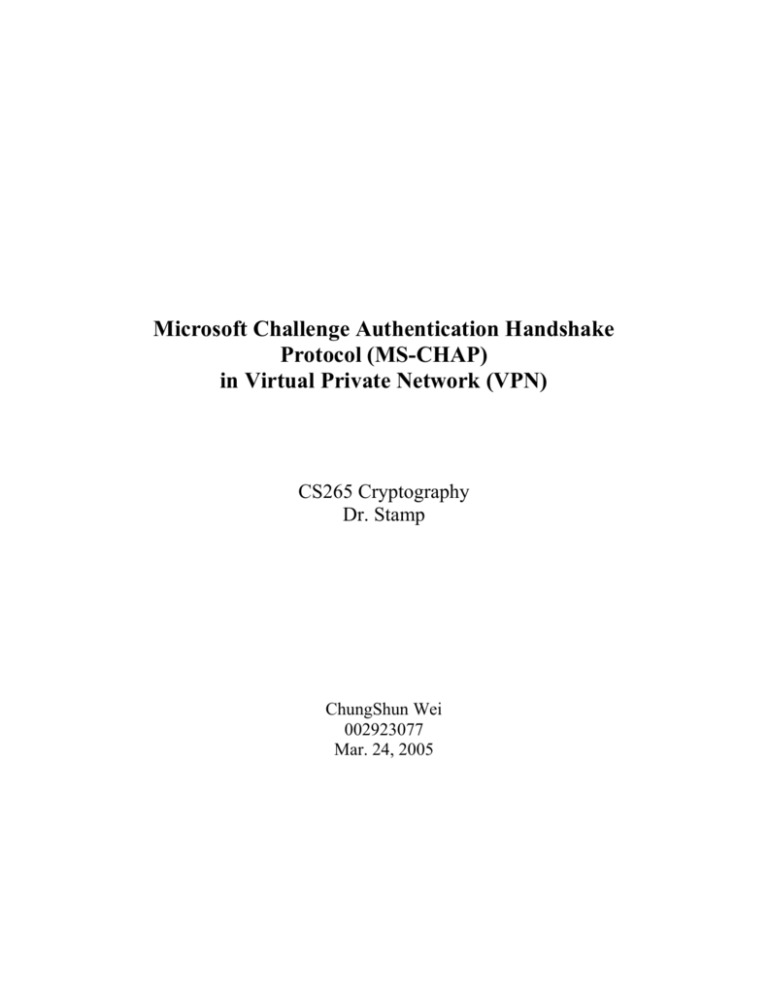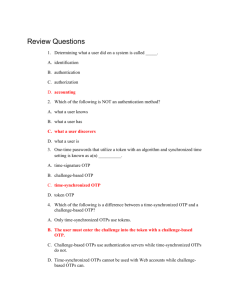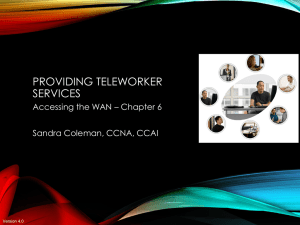MS-CHAP
advertisement

Microsoft Challenge Authentication Handshake Protocol (MS-CHAP) in Virtual Private Network (VPN) CS265 Cryptography Dr. Stamp ChungShun Wei 002923077 Mar. 24, 2005 1. Introduction After the telephone has been invented, one can just dial numbers on the telephone and talk to another who may be living on a different continent from the caller. This may seem to be an evolutionary invention 60 years ago. However, today, the Internet can perform an even powerful communication channel between two end points worldwide. Not only the Internet can deliver voice, but it can also transmit all formats of data, such as image, text, and video. The Internet provides tremendous convenience for people to communicate with each other around the world. The Internet also allows businessman to join a conference meeting or to access company’s private networks without physically being in the company office. The technology behind this private networking access is called Virtual Private Network (VPN) which can authenticate remote users and encrypt the data traveling through the channel. VPN technology utilizes the Internet to carry data packets from the source point to the destination host. This seems to be highly insecure when company employees may send confidential information through the public internet. This paper will discuss and analyze Microsoft Challenge Handshake Authentication Protocol (MS-CHAP) which is the authentication protocol that Microsoft Windows uses to protect the data traveling between remote users and VPN servers. 2. Virtual Private Network (VPN) Virtual Private Network (VPN) can be seen as a private network that is restricted to outside access for security and confidentiality reasons. VPN is often being deployed by corporations to establish company private networks and allow remote employees who are not physically sitting in local company offices to access the company’s private network and logically equal to be connecting to the company’s private network locally. VPN is also used when two branches of the same company wishes to share information. They can use VPN tunneling through Wide Area Network (WAN) and form a logically equivalent private Local Area Network (LAN) connection between these two branches shown in Figure 2.1. If a remote employee/client wants to connect to a VPN. There are two methods for the client to initiate the connection. The first method is through a modem on the client machine. The client can dial a number to a Remote Access Server (VPN server) that will generate a dedicated phone line connection from the client machine to the company’s private network. Then, the data will be sent through this dedicated phone line. This is usually called Remote Access Service. The disadvantage of this method is that the client sometimes will require dialing a long-distance phone call to get to the VPN server. Also, each client that is connected to the VPN server requires a direct phone line connection. This method is too costly and resource-consuming. The second method is to use a current existing internet service from Internet Service Provider (ISP) and connect the client’s machine to the company’s VPN shown in Figure 2.2. The data are no long traversing through a phone line; instead, they are routed through the Internet to the VPN server. The advantage of this method is that clients can avoid costly long-distance phone calls. Also, there is no dedicated phone line required for each client who connects to VPN [H02]. Figure 2.1 Virtual Private Network (VPN) Connecting Two Company Branches Figure 2.2 A VPN Connection Connecting a Remote Client to a Private Intranet VPN basically provides four properties: 1. Encapsulation 2. Authentication 3. Data encryption 4. Address and name server allocation VPN authentication is the main focus in the article. Next section, we are going to discuss in detail on two VPN authentication protocols—Password Authentication Protocol (PAP) and Challenge Handshake Authentication Protocol (CHAP). They are both using symmetric key system to authenticate remote clients. The user information including passwords is usually stored on a database server—Remote Authentication Dial-in User Service (RADIUS)—sitting locally with the VPN server [H02]. 3. Authentication Protocol 3.1 Password Authentication Protocol (PAP) After a connection is established between the client and the VPN server, the VPN server can request the connection to use Password Authentication Protocol (PAP) for authentication. Next, the client has to send his/her username and password in clear text to the VPN server. This protocol is highly insecure to allow password traveling through public internet without encryption. The reason that any client should ever use PAP is when the client dials into a VPN server that only understand clear-text password or don’t support any encrypted password protocol [HR]. Because of this drawback, we are going to move our attention to a more secure authentication protocol—Challenge Handshake Authentication Protocol (CHAP). 3.2 Challenge Handshake Authentication Protocol (CHAP) Challenge Handshake Authentication protocol (CHAP) is considered more secure than Password Authentication Protocol (PAP) because it encrypts the password as well as the data. One of the requirements of CHAP is that both end points must have a shared secret key before they can start transmitting any passwords or data. Actually, there are many versions of CHAP existed today. Their fundamental methodology is similar to one another, but some improvements on security can be discussed among them. CHAP is the most basic Challenge Handshake Authentication Protocol which is not as popular as Microsoft Challenge Handshake Authentication Protocol (MS-CHAP). MS-CHAP is basically used in all Windows operating system. MS-CHAP currently has two versions. MS-CHAP version 1 (MS-CHAPv1) has been found some serious security vulnerabilities. Therefore, MS-CHAP version 2 (MS-CHAPv2) is the most popular authentication protocol used in Windows operating system today [HR]. Since MS-CHAPv2 is the most up-to-date CHAP protocol, we are going to analyze it and will introduce the improvements on MS-CHAPv2 over MS-CHAPv1. 3.3 Microsoft Challenge Authentication Handshake Protocol, Version 2 (MSCHAPv2) Since all Challenge Authentication Handshake Protocols are similar with some improvements on security issues, we will focus our attention to MS-CHAPv2 and discuss some differences and improvements between MS-CHAPv1 and MS-CHAPv2. Let’s first look at the authentication procedure of MS-CHAPv2 [SB99]. 1. Client requests a login challenge from the server. 2. The server generates a 16-byte random challenge and sends to the client. (In MSCHAPv1, an 8-byte challenge is generated instead of 16-byte challenge). 3. On receipt of the 16-byte random challenge from the server, the client generates its own 16-byte random challenge called Peer Authenticator Challenge. 4. With the 16-byte random challenge from server, 16-byte Peer Authenticator Challenge, and the client’s username, the client now concatenates these three values and feed to a SHA-1 hash function. The first 8 byte of the output value from the SHA-1 hash function will be picked out as the 8-byte challenge. A graphic illustration is shown in Figure 3.1. 5. With the 8-byte challenge, the client continues using this challenge and Windows NT hash function to create a 24-byte reply. This computation will also be described later. (This part is identical to MS-CHAPv1 except that MS-CHAPv1 uses both LAN Manager and Windows NT hash functions to hash the client’s password twice and concatenate two 24-byte hash values into a 48-byte reply. Since LAN Manager hash function is considered much weaker than Windows NT hash function. MS-CHAPv2 eliminates the step of hashing client’s password with LAN Manager hash function). 6. The client then sends the 24-byte reply together with the Peer Authenticator Challenge from Step 3. 7. By retrieving the client’s password stored in database based on the client’s username, the server can decrypt the 24-byte reply and compare with the 8-byte challenge. If they are matched, the client is authenticated. 8. The server then uses the 16-byte Peer Authenticator Challenge and the client’s hashed password to create a 20-byte Authenticator Response. 9. After receiving the Authenticator Response, the client computes its own Authenticator Response and compares with the Authenticator Response from the server. If they are matched, the server is authenticated. Random challenge (16 bytes) Generated by Server Peer Authenticator Challenge (16 bytes) Generated by Client Client’s username concatenate Hash (SHA-1) Challenge (the first 8 bytes) Figure 3.1 Generating 8-byte Challenge Although we have seen improvements that MS-CHAPv2 has done over MS-CHAPv1, there are still security and design loopholes that allow attackers to obtain client’s password. Now, we will look closely at some of these potential security vulnerabilities in MS-CHAPv2. 3.3.1 Generating 8-byte Challenge First, let’s explore how the 8-byte challenge in step 4 was actually generated in both MSCHAPv1 and MS-CHAPv2. In MS-CHAPv1, this 8-byte challenge is randomly generated by the server and sent to the client. Clearly, this is a security problem which allows eavesdroppers to acquire this 8-byte challenge by simply listening to the channel between the server and the client. In contrast, MS-CHAPv2 does not require the 8challenge to be transmitted from the server to the client. It utilized a server’s 16-byte random challenge and a client’s 16-byte Peer Authenticator Challenge, and the client’s username to generate the 8-byte challenge at the client site. This can prevent eavesdroppers to obtain this 8-byte challenge. Although this may seem to be a complicated computation and highly secure design, this step is just a waste in security perspective. In step 6, the client is actually sending the 24-byte reply together with the Peer Authenticator Challenge to the server. If the eavesdropper is listening on the channel from step 2 to step 6, he/she can still find out the 8-byte challenge by computing it himself/herself with all the information obtained from the channel. As a result, this improvement of MS-CHAPv2 does not seem to be any securer than MS-CHAPv1 [SB99]. 3.3.2 Generating 24-byte MS-CHAP reply From the step 5 above, the client uses his/her password and the 8-byte challenge generated from step 4 to create a 24-byte MS-CHAP reply. In this section, the detail procedure of generating this 24-byte MS-CHAP reply will be examined. Figure 3.2 also illustrates this process. First, the client feeds his/her password to Windows NT hash function and will obtain a 16-byte output value. This 16-byte output value will then be padded with five zero bytes to 21 bytes long. Next, the 21-byte string will be cut into three 7-byte DES keys. In Figure 3.2, I called these three keys as DES key 1, DES key 2, DES key 3. Each of these keys will be used to encrypt the 8-byte challenge. Finally, these three encrypted blocks will be concatenated into a 24-byte MS-CHAP reply. password input NT hash Output (16 bytes) 16 bytes is padded to 21 bytes with 0 21-byte output split into 3 7-byte DES keys DES key 1 (7 bytes) DES key 2 (7 bytes) DES key 3 (7 bytes) (xx00000) encrypt encrypt cncrypt challenge (8 bytes) challenge (8 bytes) challenge (8 bytes) concatenate MS-CHAP reply (24 bytes) Figure 3.2 Generating 24-byte MS-CHAP reply This 24-byte MS-CHAP reply is generated through a complicated algorithm. It is also long enough to be secure. However, 192 bit long does not mean that the attacker must try all 2192 possible DES key values to decrypt this MS-CHAP reply. Remember that the last 5 bytes of the 24-byte MS-CHAP reply are all zeros. That is, DES key 3 only has 2 bytes for the attacker to guess. This only takes 216 tries to find out the real key value. Although there are still 14 bytes left, it does not take 2112 tries to search the DES key. Because DES key1 and DES key 2 are used separately to encrypt the challenge. Only 2 * 256 tries is needed to obtain both DES key 1 and DES key 2. As a result, the total efforts that a attacker requires to find out all three DES keys are (216 + 257). Besides using brute force method, the attacker could easily speed up the search by dictionary key search. Since human passwords are often related or derived from a word or phrase in dictionary. By trying dictionary words as passwords may help decreasing the time required to break the password. As a matter of fact, an experiment was conducted to break the password using a single EFF DES Cracker machine in 9 days. In the article, Cryptanalysis of Microsoft's PPTP Authentication Extensions (MS-CHAPv2), Schneier and Mudge suggested a simple method to avoid this serious weakness. That is, to generate the MS-CHAP reply by using SHA-1 hash function to hash both 16-byte output from Windows NT hash and the 8-byte challenge [SB99]. This technique would be enough to prevent this kind of attack. 4. Conclusion VPN is the most popular methodology that corporations prefer to allow employees or clients accessing company’s private network. It is extremely important that data traveling between the employees and the VPN server is secure because confidential information may be sent through this VPN channel. Because of the significance of transmitting confidential data through VPN, Microsoft has developed its proprietary version of Challenge Handshake Authentication Protocol (CHAP) called Microsoft Challenge Handshake Authentication Protocol (MS-CHAP) which allows a VPN server to authenticate its clients. MS-CHAP has two versions. Because version 1 was found to have many security vulnerabilities, Microsoft released MS-CHAP version 2 with security improvements over MS-CHAPv1. Although today most of the Windows operating systems are using MS-CHAPv2 as the authentication protocol to talk to the Windows VPN server, researchers still find vulnerabilities on MS-CHAPv2 and actually ran an experiment to break it. Nevertheless, authentication phase is only a part of security protection in VPN. With the encryption and other security technology that VPN provides, VPN is still the most favorable method that companies used for their remote access. 5. References [AZ97] Alexander, Zubair. Is RAS Safe. December 1997. <http://www.windowsitpro.com/Article/ArticleID/135/135.html?Ad=1>. [FM97] Ford, Merilee; Lew, H. Kim; Spanier, Steve; Stevenson, Tim; Inc Cisco Systems. Internetworking Technologies Handbook. Cisco Press. March 1, 1997. [HR] Haden, Rhys. Data Network Resource: Point to Point Protocol (PPP). <http://www.rhyshaden.com/ppp.htm>. [H02] Homebase.com. Virtual Private Networking. Technical References. Nov. 8, 2002 <http://endeavorquest.net:8880/knowbase/vpnsetup.htm>. [SB98] Schneier, Bruce; Mudge, P. Cryptanalysis of Microsoft's Point-to-Point tunneling protocol (PPTP). Technical report, Counterpane Systems, June 1998. <http://citeseer.ist.psu.edu/article/schneier98cryptanalysis.html>. [SB99] Schneier, Bruce; Mudge, P. Cryptanalysis of Microsoft's PPTP Authentication Extensions (MS-CHAPv2). Technical report, Counterpane Systems, October 19, 1999. <http://www.schneier.com/paper-pptpv2.html>. [SW96] Simpson W. RFC 1994: PPP Challenge Handshake Authentication Protocol (CHAP). August 1996 <http://www.cse.ohio-state.edu/cgi-bin/rfc/rfc1994.html>.








